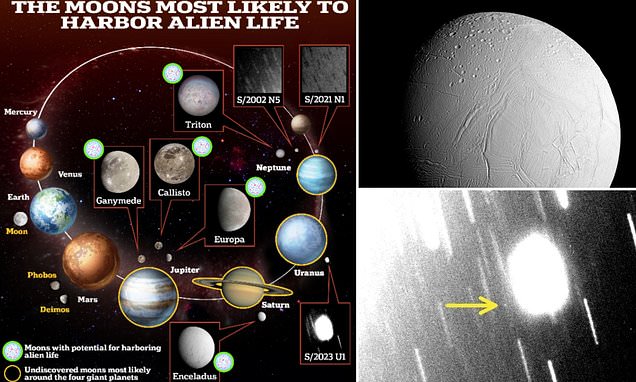It is a significant mystery in the field of science – the exploration to unveil the presence of life beyond our planet. The fundamental query persists: Where might it be situated?
Contrary to the idea that the solution lies in the far-flung realms of the universe, the truth could be much nearer to us than previously envisioned.
In our own solar system, there exist celestial bodies – some of which display conditions that could support life.
Among these, which ones emerge as the most promising candidates?
From Europa, one of Jupiter’s moons, to Enceladus, a moon of Saturn, an in-depth analysis identifies these moons as primary contenders for potentially hosting life.
How many moons does each planet have?
- Mercury: 0
- Venus: 0
- Earth: 1
- Mars: 2
- Jupiter: 95
- Saturn: 146
- Uranus: 28
- Neptune: 16
Total: 293
As per experts, the top candidates for accommodating some form of life encompass Enceladus, Saturn’s moon, which emits.
 ].
].

Europa, Jupiter’s moon, is recognized to shelter, a compound vital for cellular function on Earth. Additionally, Ganymede, Jupiter’s largest moon, is theorized to possess a subsurface salty ocean – a potential sanctuary for life forms.
Titan, Saturn’s largest moon, is presumed to have a blend of water and rock interacting, a fundamental process for life genesis. Furthermore, Titan flaunts a predominantly nitrogen-based atmosphere akin to Earth’s.
Recent revelations by scientists unveiled the presence of [ ] – one encircling Uranus and two orbiting Neptune.
] – one encircling Uranus and two orbiting Neptune.
Notably, NASA proposes that numerous other undiscovered moons may lie within our solar system, awaiting detection.
Dr. Robert Massey, the deputy executive director of the Royal Astronomical Society, concurs with NASA’s assertion, underscoring the probability of unidentified moons around the gas giants – Jupiter, Saturn, Uranus, and Neptune.
However, these potential moons are expected to be considerably smaller in size compared to the aforementioned candidates, ranging from a few hundred to tens of miles in diameter.
‘Moons discovered presently are typically much smaller – no more than a few kilometers across – and consequently much dimmer, necessitating advanced and more sensitive telescopes for detection.’
Recent findings unveiled three new moons – two orbiting Neptune and one orbiting Uranus. Nevertheless, Dr. Massey deems it ‘highly improbable’ for these [ ] to support alien life due to their diminutive size, lack of atmosphere, and presumed absence of subsurface oceans.
] to support alien life due to their diminutive size, lack of atmosphere, and presumed absence of subsurface oceans.
In general, the feasibility of a moon to sustain life diminishes with its size, as a requisite for life is the presence of a stable atmosphere.
Professor Martin Hendry from the University of Glasgow’s school of physics and astronomy elucidated, ‘Moons lacking sufficient size lack the gravitational force necessary to retain an atmosphere, rendering it uninhabitable.’
He further explained that excessively minute moons are susceptible to tidal forces that could disintegrate them.
Despite the technological advancements in ground-based telescopes, many undiscovered moons remain imperceptible due to their faintness.
‘Both planets and moons do not emit light independently but instead reflect sunlight,’ Professor Hendry clarified. ‘Moons orbiting at a considerable distance from a planet, which is itself distantly positioned from the sun, reflect minimal sunlight.’
Dr. Scott S. Sheppard, an astronomer at the Carnegie Institution for Science, expressed skepticism regarding NASA’s claim of ‘thousands’ of undiscovered moons, attributing the challenge of detection to their diminutive size and faintness beyond the capabilities of current technology.
‘Our existing largest telescopes are constrained in their imaging depth, hence imposing limitations on moon discovery,’ he remarked.
‘These yet-to-be-identified moons, ranging from a few to tens of kilometers in size, are improbable candidates for current life forms. However, they might contain the essential components for life on their surfaces, presumed to be rich in ice and organics.’
The recent identification of three new moons has elevated total known moons to 16, while Uranus now boasts 28 moons, though still modest compared to Jupiter.
 ].
].
Jupiter hosts 95 moons, whereas Saturn boasts a staggering 146 moons, with the count steadily increasing.
The possibility of extraterrestrial life extends beyond our solar system to exoplanets and exomoons – planets and moons orbiting stars outside our solar system.
NASA estimates billions of exoplanets, some of which likely possess Earth-like conditions conducive to sustaining life.
NASA scientist is ‘absolutely certain’ there is alien life in our Solar System – and reveals why extraterrestrials are most likely to be hiding on Venus
Venus, a planet plagued by searing temperatures of 475°C (900°F) beneath a dense acidic atmosphere, may seem an unlikely abode for life as we know it.
However, Dr. Michelle Thaller, a research scientist at the Goddard Space Flight Center in the U.S., proposes a radical notion that extraterrestrial life forms could be concealing themselves on Venus amidst conditions deemed inhospitable for humans.
Dr. Thaller contends that potential indicators of life have been detected within Venus’s carbon-dioxide-rich atmosphere, asserting her unwavering belief in the existence of extraterrestrial life elsewhere.
